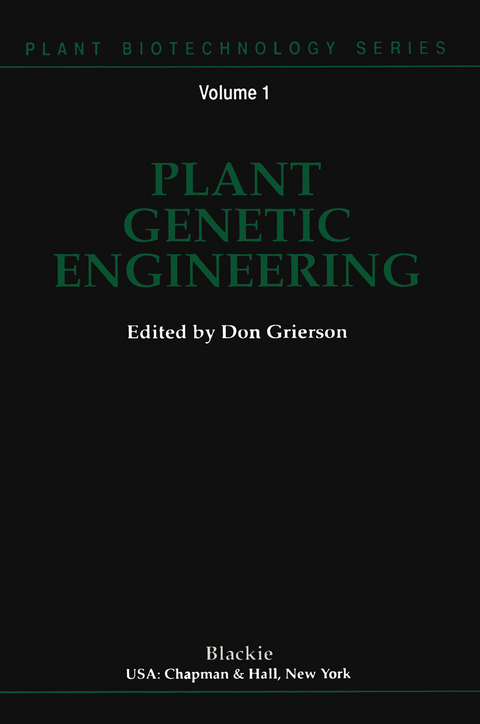
Plant Genetic Engineering
Springer (Verlag)
978-94-010-6668-6 (ISBN)
Plant biotechnology offers important opportunities for agriculture, horticul ture, and the food industry by generating new transgenic crop varieties with altered properties. This is likely to change farming practices, improve the quality of fresh and processed plant products, and reduce the impact of food production on the environment. The purpose of this series is to review the basic science that underpins plant biotechnology and to show how this knowledge is being used in directed plant breeding. It is intended for those involved in fundamental and applied research on transgenic plants in the academic and commercial sectors. The first volume deals with plant genes, how they work, and their transfer from one organism to another. Authors discuss the production and evaluation of the first generation of transgenic crops resistant to insects, viruses and herbicides, and consider aspects of gene regulation and targeting of their protein products to the correct cellular location. All the contributors are actively engaged in research in plant biotechnology and several are concerned directly with its commercial applications. Their chapters highlight the importance of a fundamental understanding of plant physiology, biochemistry, and cell and molecular biology for the successful genetic engineering of plants. This interdisciplinary approach, which focuses research from traditionally separate areas, is the key to further developments which are considered in subsequent volumes. Don Grierson Contributors Alan B. Bennett Mann Laboratory, Department of Vegetable Crops, University of California, Davis, CA 95616 John W. s.
1 Plant gene structure and expression.- 1.1 Introduction.- 1.2 Protein-coding genes.- 1.3 Regulation of plant gene expression.- 1.4 Translational control.- 1.5 Differential expression.- 1.6 RNA-coding genes.- 1.7 RNA genes transcribed by RNA polymerase I.- 1.8 RNA genes transcribed by RNA polymerase II.- 1.9 RNA genes transcribed by RNA polymerase III.- References.- 2 Gene transfer to plants.- 2.1 Introduction.- 2.2 Vectors based on the Agrobacterium Ti plasmid.- 2.3 Physical DNA delivery methods.- 2.4 Uses of gene transfer technology.- References.- 3 Developing herbicide resistance in crops by gene transfer technology.- 3.1 Introduction.- 3.2 Modification of the target of herbicide action.- 3.3 Detoxification or degradation of the herbicide.- 3.4 Perspectives.- References.- 4 Genetic engineering of plants for insect resistance.- 4.1 Introduction.- 4.2 Defensive methods used by plants against insect attack.- 4.3 Insecticidal compounds from other sources.- 4.4 Constraints on the genetic engineering of plants for insect resistance.- 4.5 The production of insect-resistant transgenic plants: two case studies.- 4.6 Future prospects.- References.- 5 Virus-resistant plants.- 5.1 Introduction.- 5.2 Basic concepts of resistance to plant virus infection.- 5.3 Key features of the infection cycles of positive-strand RNA plant viruses.- 5.4 Molecular bases and exploitation of naturally occurring virus resistance genes.- 5.5 Construction and expression of artificial resistance genes in transgenic plants.- 5.6 Future prospects.- References.- 6 Targeting of proteins to chloroplasts and mitochondria.- 6.1 Introduction.- 6.2 Structure and biogenesis of chloroplasts.- 6.3 Import of stromal proteins.- 6.4 Transport of proteins into the thylakoid system.- 6.5 Import of proteins into the envelope membranes.- 6.6 Transport of proteins into mitochondria.- References.- 7 Protein transport and targeting within the endomembrane system of plants.- 7.1 Introduction.- 7.2 Biogenesis of endomembrane compartments.- 7.3 Mechanisms of protein transport.- 7.4 Mechanisms of protein sorting.- 7.5 Glycosylation and post-translational modification.- References.- 8 Identification and characterisation of tissue-specific genes from flowers.- 8.1 Introduction.- 8.2 Identification of flower-specific genes.- 8.3 Characterisation of gene expression in floral organs.- 8.4 Tissue and cell specificity of gene expression in flowers.- 8.5 Discussion.- References.
| Reihe/Serie | Plant Biotechnology Series |
|---|---|
| Zusatzinfo | 267 p. |
| Verlagsort | Dordrecht |
| Sprache | englisch |
| Maße | 152 x 229 mm |
| Themenwelt | Studium ► 2. Studienabschnitt (Klinik) ► Humangenetik |
| Naturwissenschaften ► Biologie ► Botanik | |
| Naturwissenschaften ► Biologie ► Zoologie | |
| Technik ► Umwelttechnik / Biotechnologie | |
| Weitere Fachgebiete ► Land- / Forstwirtschaft / Fischerei | |
| ISBN-10 | 94-010-6668-X / 940106668X |
| ISBN-13 | 978-94-010-6668-6 / 9789401066686 |
| Zustand | Neuware |
| Haben Sie eine Frage zum Produkt? |
aus dem Bereich


